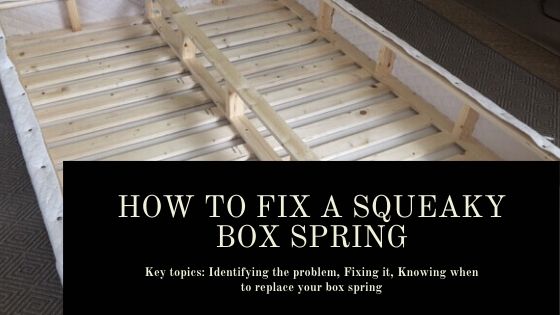
Thinking about how to fix a noisy, squeaky box spring ? It may not be the underlying problem! In this article, we will provide you with reasons why you might have a squeaky box spring, how to identify any problems, and a step-by-step guide for fixing those problems. We also give you a way to tell when you need to replace your box spring. Make sure you check out our favorite box springs via the link.
Related topics:
- Do you need a box spring?
- How long does a box spring last?
- What box spring height should you choose for your next box spring?
Reasons for Noisy or Squeaky Box Springs in General
There are a few reasons why your bed might be squeaking. Sometimes the noise does not come from the box spring itself. It may originate from the mattress or the connection between the box spring and the bed frame that supports it.
Reason 1: The Mattress
All mattresses eventually start sagging, especially innerspring mattresses that contain metal coils. Here is an example of a high-quality innerspring mattress. Over time, the more pressure you put on the mattress, the more likely the springs will wear out and rub on each other, causing a squeaking noise. Although replacing the mattress is the best solution, there are a few temporary methods to eliminate the sound and make the mattress more comfortable.
Reason 2: The Box Spring
The coils and wooden panel in box springs are the most common source of squeaking. Springs naturally deteriorate over time and squeak due to metal rubbing on metal. However, the noise does not always originate from the internal parts of the box spring.
When you move in bed, the mattress presses directly on top of the wood casing of the box spring. This wood casing rubs against the wood slats or the metal of the bed frame to create a squeaking sound. Adding some padding or lubricant between these surfaces will reduce this friction and diminish the squeaking noise. WD-40 is a standard solution to this problem.
Reason 3: The Bed Frame
The squeaky sound could be coming from the bed frame itself or its contact with the walls and floor. Frequent movement, low temperature, or heavy weight can loosen bed frame bolts over time, creating an unsteady, unstable, and squeaky structure.
Temperature shifts can affect metal bolts and wooden bed frames alike, as wood swells and shrinks with heat. This fluctuation in the wood can cause it to rub against itself and generate a squeaky sound.
The legs of the bed can also rub against the floor or scrape against the wall, each creating a shrill noise. Wheels on the bottom of a bed can grind along the floor and cause squeaking.
Related article:
- Make sure you’re not unintentionally misusing a box spring…for example using a box spring on a bunk bed
How to Identify the Problem
| If You Notice This… | How to Fix a Squeaky Box Spring + the underlying Cause |
| Sagging mattress | The constant pressure on the coils and springs causes them to sag and rub onto each other, producing a squeaky sound. Read below to learn how to restore sagging coils and springs. |
| Sagging box spring | If the internal springs are old, they deteriorate and rub against each other, causing a squeaky sound. Read below to learn how to lubricate deteriorating coils and fix the issue. |
| Box spring moves on the frame | Friction between the box spring and the frame causes noise. Read below for a guide on how to pad the area between these surfaces and fix the friction and noise. |
| Box spring moves on a wooden frame | A gap between the box spring and the wooden slats of the bed frame is producing the sound. Read below to learn how to eliminate the noise by padding and lubricating the squeaky area. |
| Box spring moves on a metal frame | The bolts and joints of the metal frame, such as this one, are creating the noise. These connectors need oil or wax for lubrication. Read below to learn how to apply these lubricants. |
| Loose bolts | Weak or loose joints can create squeaking noises. Read below to discover how to repair weak and loose joints. |
| Uneven bed legs rubbing against the floor | An uneven bed leg might not touch the floor, causing it to squeak and scrape against the floor as you shift the bed. Read below to learn how to fix a wobbly bed and eliminate the sound. |
| Wheels under the bed scraping against the floor | The movement of the wheels scrapes against the floor to produce a squeaking sound. Read below to learn how to block the wheels in place, stop the friction, and prevent the noise. |
How to Fix a Squeaky Box Spring
Fixing Sagging Coils and Springs
If the reason for the squeaky sound is the sagging of the coils and springs inside a mattress or box spring, then you can temporarily fix the issue by reinforcing the foundation either by rotating it, picture (a) below, or adding plywood, picture (b) below.
Rotating the Mattress
Step 1
Put the mattress on the floor and test it by pushing on various locations to determine the source of the noise.
Step 2
If you notice a sagging spot on the mattress, then the squeak is probably coming from sagging springs. Turn the mattress 180 degrees so that the head of the mattress becomes the foot and vice versa. Refer to picture (a) below.
Adding Plywood
Materials Needed:
- Plywood
Step 1
Measure and cut the plywood to match the dimensions of the box spring and mattress. Here is a fantastic example of plywood for this project.
Step 2
Lay a thin sheet of plywood down on the bed frame between the mattress and the box spring. The plywood will support the mattress from beneath, stopping it from sagging and preventing squeaking. Refer to picture (b) below.
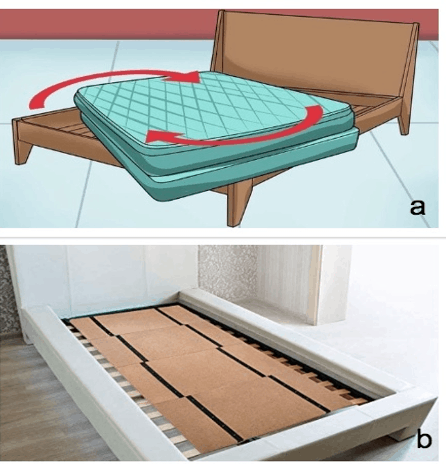 Moving the head of the mattress toward the bed’s foot using a 180 degrees rotation to change the sagging points (a). Placing a thin sheet of plywood on the wooden slats of the bed frame to improve the firmness and stop any squeaking (b).
Moving the head of the mattress toward the bed’s foot using a 180 degrees rotation to change the sagging points (a). Placing a thin sheet of plywood on the wooden slats of the bed frame to improve the firmness and stop any squeaking (b).Fixing Noisy Box Springs & Deteriorating Coils Inside the Box Spring
If the internal springs are old, they can rub against each other and cause a squeaky sound. These internal springs require a lubricant to stop squeaking.
Materials Needed:
- Knife or box cutter
- WD-40 or cooking oil
- Sewing thread and needle
Step 1
Cut a small hole in the felt cover of the box spring using a knife or a box cutter, such as this one. This hole should expose the internal springs and structure of the box spring. Related topic: Changing box spring covers.
Step 2
Spray WD-40 or cooking oil along the inside of the box spring and all over the coils and springs. The lubricant will cause the springs to become slippery, diminishing any metal tension and reducing squeaking noises. The picture below demonstrates this process. Here is an easy-to-use can of WD-40 with a non-aerosol trigger to spray quickly and accurately.
Step 3
Use a robust sewing thread and needle to close the opening you made earlier.
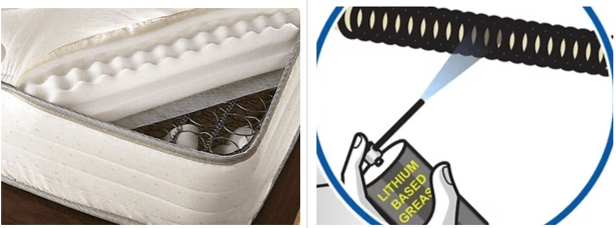 Opening a side of the box spring and lubricating its coils and internal parts with WD-40 to reduce squeaking noises.
Opening a side of the box spring and lubricating its coils and internal parts with WD-40 to reduce squeaking noises.Fixing Friction Between the Box Spring and the Bed Frame
If the reason for the squeaky sound is the box spring rubbing against the bed frame, then reduce the friction by placing padding between them.
Materials Needed:
- Old fabric (socks, t-shirts, etc.)
- A hardcover book
Step 1
Locate the exact location of the bed frame that is rubbing against the box spring and creating the squeaking noise.
Step 2
Pad this location with some old fabric, such as socks or t-shirts. Evenly distribute these garments along the inside of the bed frame, as well as between the mattress and box spring. The padded area serves as a buffer between the box spring and other parts of the bed, diminishing any points of friction and eliminating squeaking sounds. Refer to picture (a) below.
Step 3
Place a hardcover book under the exact spot creating the squeaking noise. This placement will alter the weight distribution of the box spring, changing the pressure point of any squeaky springs. Any hardcover book will do, including this one. Check picture (b) below.
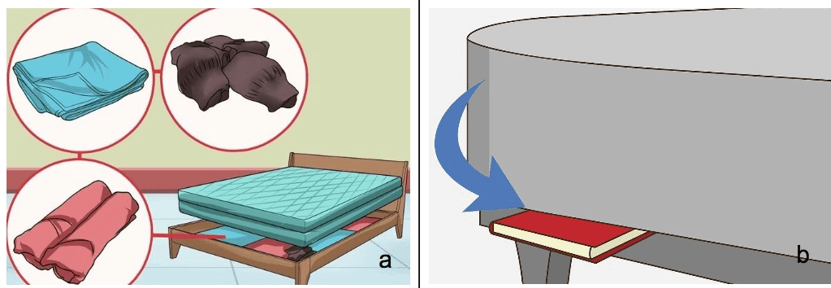 Padding the squeaky area with old fabric (a) and a hardcover book (b) to prevent rubbing and the squeaking.
Padding the squeaky area with old fabric (a) and a hardcover book (b) to prevent rubbing and the squeaking.Fixing the Gap Between the Box Spring and the Wooden Bed Frame
If the reason for the squeaky sound is a gap between the box spring and the wooden bed frame, then you can fill the gap with cork.
Using a Cork Roll
Materials Needed:
- Cork roll
Step 1
Check for empty spaces where the box spring can move and rub against the wooden bed frame.
Step 2
Cut a roll of cork into sheets and cover the empty spaces between the wooden slats of the bed frame. This cork sealant will tighten any loose spots, reduce the tension on tight spots, and solve the squeaking noise. Here is an excellent cork roll for fixing the gap. Refer to picture (a) below.
Lubricating the Wooden Frame With Wax
Materials Needed:
- Paraffin blocks or candle wax
- Knife
Step 1
Warm a brick of paraffin by leaving it out at room temperature.
Step 2
Cut a piece of the brick with a knife into a shape similar to a sponge. This paraffin wax block already comes in four distinct sections, and you can break it apart easily.
Step 3
Rub the paraffin across any areas creating a squeaking noise. Check picture (b) below. An alternative to paraffin wax is to use an unlit candle and apply it to the wood surface in the same way as you would with paraffin.
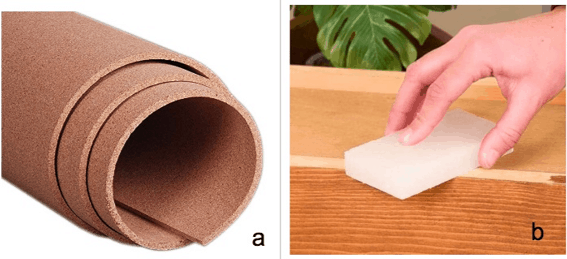 Reducing friction between the box spring and a wooden bed frame by using cork (a) or lubricating the wood surface with paraffin wax (b).
Reducing friction between the box spring and a wooden bed frame by using cork (a) or lubricating the wood surface with paraffin wax (b).Fixing the Bolts of a Metal Bed Frame
If the reason for the squeaky sound is the box spring’s corners rubbing against a metal bed frame, then you need to lubricate all the bed frame connectors. Check the picture below.
Materials Needed:
- WD-40 or cooking oil
Step 1
Spray WD-40 or apply cooking oil to the joints and bolts of the metal bed frame. This pack of WD-40 will ensure you have enough for the job.
Step 2
Lubricate the corners of the metal frame to ensure smooth points of contact.
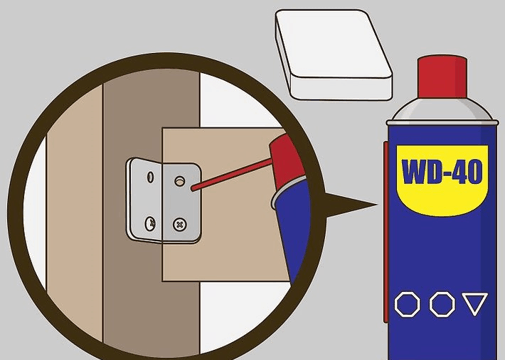 Lubricating the bed’s bolts by using WD-40 oil spray to eliminate the squeaking sound.
Lubricating the bed’s bolts by using WD-40 oil spray to eliminate the squeaking sound.Fixing Weak or Loose Joints
If the reason for the squeaky sound is weak or loose joints, then utilize the bolt method to fix the issue.
Materials Needed:
- Bolts or screws
- Wrench or screwdriver
- Washers
Step 1
Check around your bed frame and take note of what type of threaded fasteners your bed uses. Typically, bed frames use either bolts or screws. Refer to the picture below.
Step 2
Use a wrench if your bed frame uses bolts, or a screwdriver if it uses screws, and tighten all the joints. This wrench will make tightening bolts quick and easy.
Step 3
If the squeaking noise persists, add washers between the bolt and the frame to create a sturdier connection.
Step 4
Prevent future squeaks lubricating each joint of the bed frame with either WD-40 or cooking oil.
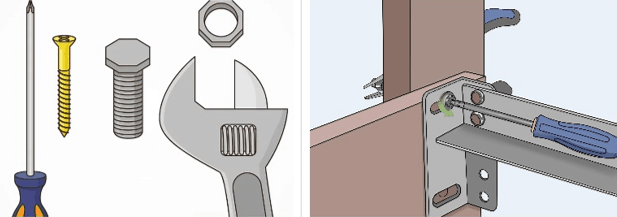 Tightening weak or loose joints with a wrench or screwdriver to fix the squeaky sound.
Tightening weak or loose joints with a wrench or screwdriver to fix the squeaky sound.Fixing an Uneven Bed Leg
If the reason for the squeaky sound is an uneven bed leg rubbing against the floor and causing the bed to wobble, then you need to level the bed legs.
Materials Needed:
- Furniture pads for the floor
- Rubber leg covers
Step 1
Raise the corner of the bed where you have an uneven leg that doesn’t touch the ground.
Step 2
Place a furniture pad underneath this leg. This method prevents the bed from wobbling and creating any annoying sounds. Here are some furniture pads that will work great for leveling uneven bed legs. Check picture (a) below.
Step 3
Use rubber leg covers by slipping one on each leg to reduce the squeaking and scratching of the bed along the floor. These rubber leg covers are flexible, making them suitable for bed legs. Check picture (b) below.
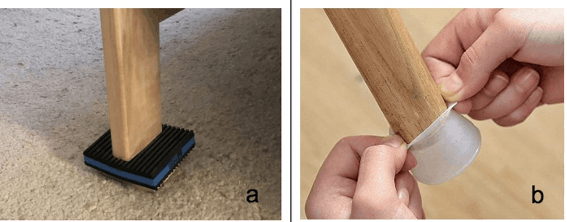 Using furniture pads (a) or rubber leg protectors (b) to avoid scratches and noise between the bed’s uneven legs and the floor.
Using furniture pads (a) or rubber leg protectors (b) to avoid scratches and noise between the bed’s uneven legs and the floor.Fixing the Rubbing Between Wheels and the Floor
If the reason for the squeaky sound is the wheels under the bed, then you need to stop the wheels from rubbing against the floor.
Materials Needed:
- Caster cups
- Locking casters
Step 1
Place a caster cup under each wheel to block the wheel from moving. These caster cups will ensure nothing moves unexpectedly. Check picture (a) below.
Step 2
If your bed comes with locking wheels, then flip the lever on the side of each wheel to engage the lock and disable them entirely.
Step 3
If your bed does not come with locking wheels, install a set of locking casters. Push the lever down on each caster to engage the brakes and prevent them from shifting. These locking casters offer the brake function. Refer to picture (b) below.
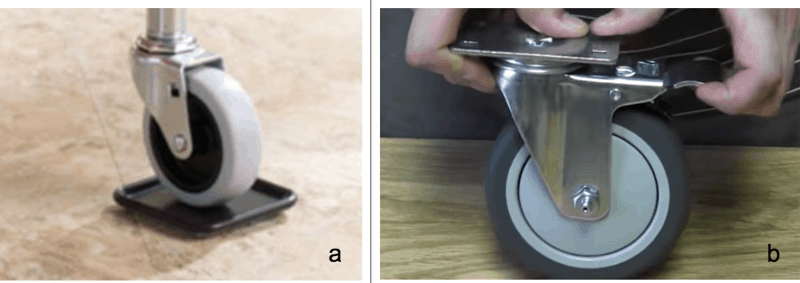 Blocking the wheels under the bed using caster cups (a) or locking wheels with a brake (b) to prevent them from rubbing against the floor and squeaking.
Blocking the wheels under the bed using caster cups (a) or locking wheels with a brake (b) to prevent them from rubbing against the floor and squeaking. When to Replace a Box Spring
It is essential to have a box spring, such as this one, that is in good shape to ensure a comfortable sleep. Generally, a box spring lasts up to 10 years before it begins to deteriorate. You don’t have to replace your box spring every time you replace your mattress unless it is demonstrating some significant defects. A visual inspection may give you enough clues to decide if it is time to replace it with a new one. Some of the clues include:
- Squeaking
- Sagging
- Bent steel grid
- Aging coil springs (over 10 years old)
- Broken slats
Alternatives to Box Springs
If you are wondering whether you really need a box spring, we’ve done the analysis for you here: Do you Need a Box Spring? Box Springs are old technology so you might also consider using a platform bed (which is a great alternative that allows you to provide better airflow to your mattress and reduce heat build up. You might also consider a Bunkie board which is a cheaper alternative. However, even bunkie boards squeak if you get steel bunkie boards.
We hope that you found this article useful. Now you should know how to identify any reasons that may cause a squeaky box spring, you should know how to fix a squeaky box spring, and also ways to fix other underlying causes. Additionally, you should now understand when to replace your box spring. Get ready for a restful night’s sleep without a single squeak!
Alternatives to Box Springs
If you are wondering whether you really need a box spring, we’ve done the analysis for you here: Do you Need a Box Spring? Box Springs are old technology so you might also consider using a platform bed (which is a great alternative that allows you to provide better airflow to your mattress and reduce heat build up. You might also consider a Bunkie board which is a cheaper alternative. However, even bunkie boards squeak if you get steel bunkie boards.
We hope that you found this article useful. Now you should know how to identify any reasons that may cause a squeaky box spring, you should know how to fix a squeaky box spring, and also ways to fix other underlying causes. Additionally, you should now understand when to replace your box spring. Get ready for a restful night’s sleep without a single squeak!
